
|
 |

|
 |
Buddhavatara on stage - an interview with Siri Rama by Lalitha Venkat, Chennai Photos of performance: Lalitha Venkat e-mail: lalvenkat@yahoo.com January 8, 2004 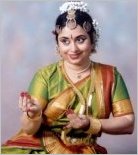 The Kanaka Sabha Performing Arts Centre, Mumbai, in association with The Lumbini Arts Society, Ottawa and SIFAS Performing Arts Company, Singapore, presented Buddhavatara, a classical dance drama in Sanskrit on January 2, 2004 at the Balamandir German Hall, Chennai for the Indian Fine Arts Society. Kanaka Sabha was established by Saroja Srinath and her daughter Siri Rama in 1982 in Mumbai. Choreographed and directed by Siri Rama, the production featured Chinese and Indian dancers from Singapore and India. Prof. V Subramaniam, a multi-faceted scholar of the Indian arts, has written the script and lyrics as well as composed the music for Buddhavatara. He has scripted and composed twenty-three dance dramas on Buddhist themes, which have been performed around the world by noted Indian choreographers. It is said that he has enriched Buddhism through the performing arts and the performing arts through Buddhism. 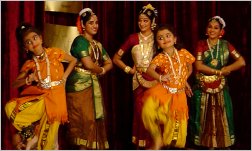 In the deer story, a deer hunter is on a killing spree. Apart from the Indian dancers, Priscilla Liew and Yeo Bee Loon alternated as the dying deer in slow ballet style movements. 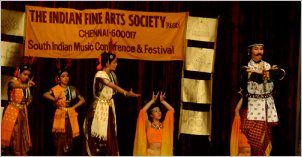 Trained in ballet, tap and jazz dance, Low Kok Wai who played the part of the hunter and later of Buddha, is currently learning Bharatanatyam in Singapore. The friend tells Queen Maya that the child in her womb is none other than the deer king to be reborn as Siddartha and the scene concludes with a dance of joy. 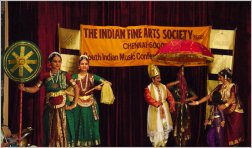
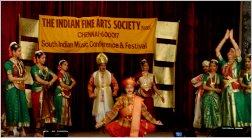 The next part of the dance drama shows King Suddhodana (Rajeshwari P Nair) arriving with great fanfare. When Queen Maya brings the child, the King summons astrologers. One astrologer predicts that the child will be a great emperor with many wives and he will vanquish many kingdoms, while the other predicts that he will be a spiritual emperor to the people. All the props used in the scene were hand made and designed by the Kanakasabha team. The Queen's sister Maya Prajavati has a vision of the future of the Buddha and the spread of Buddhism in the world. To music set on the keyboard by Kishan, this was presented almost entirely by the 3 Chinese dancers by way of their traditional ribbon dance, fan dance and a sequence where Low Kok Wai moved around the stage with a dragon head mounted on a pole. Seen purely as Chinese dance, it was entertaining, but did not quite fit in with the earlier part of the program. The whole cast assembled for the finale with chants of Buddham Saranam Gacchami. 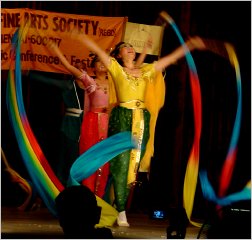
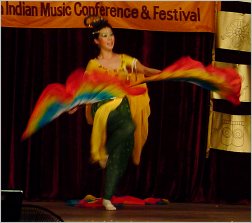
The dancers were Archana Vijaykumar, Krittika Hegde, Vidya Mani Iyer, Neeta Kamath, Sujatha N Kotian, Surekha Shetty, Shobitha Kedlaya Ravi, Sarikha S Shetty and Chandrika S Shetty. The orchestra included Narayan Mani (veena), Parameswaran (violin), Harish Raman and Siri Rama (Nattuvangam), KNP Nambisan (percussion), Rajesh Srinivasan (mridangam), Usha Srinivasan (vocal), Singapore based Bhagya Murthy on vocal and her son Kishan (keyboard). Commending Bhagya Murthy for singing true to the original compositions, Jaya Subramaniam lauded the performance and gave an open invitation to Siri Rama to perform all the works on Buddhism penned by Prof. Subramaniam, who had flown direct from the Ottawa hospital for the presentation in India. His travel was supported by the Canada Council for the Arts. Seated in a wheelchair, Prof. Subramaniam concluded the evening with his comments on the production. Siri Rama, the choreographer of Buddhavatara, talks about her interest in Buddhist related themes to narthaki.com. She is an accomplished Bharatanatyam and Kuchipudi artiste currently based in Singapore. She has performed, taught, lectured and presented solo dance recitals and dance-dramas in several countries including Hong Kong where she was based from 1992-1999, the USA, the Middle East, Germany and Singapore. She holds a PhD in dance sculpture from the University of Hong Kong and is the founder-editor of one of the premier Indian dance education sites, kanakasabha.com. 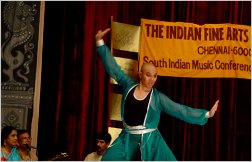 In August 1996, she performed a solo recital at the City Hall Theatre, Hong Kong for the International Computer Music Conference. The entire recital was choreographed to computer music submissions to the conferences from composers around the world. In 1997, she participated in the World Wide Simultaneous Dance Event on the web and rendered a solo interpretation of the Silappadikaram webcast as part of a course on storytelling at the University of Pennsylvania. Have you performed Buddhavatara in Singapore or elsewhere before presenting it in India? A portion of it, up to the Mruga Jataka, was presented in Singapore as Maya Dwani in May 2003. Chinese and Malay artists also participated in the performance. Based on a Jataka tale about a previous life of the Buddha, the story is about the sacrifices and good deeds in previous births of the Buddha that led to his eventually being reincarnated as the Enlightened One. 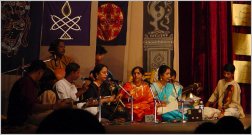 When cutting down the size of the orchestra or using recorded music is the norm nowadays, you had 9 members in the music ensemble, including 2 for vocal and 2 for nattuvangam and 2 for percussion. Though a big orchestra quite complements a big dance drama presentation, for me it was more a problem of logistics since there were shows in Mumbai and Chennai and it is very tough to book artistes during the season. Having 2 vocalists was intentional because 22 ragas are used in the music composition and I felt it would be nice to have two different voices. Bhagya has sung for me in Maya Dwani, so she was an ideal choice and she kindly agreed to come from Singapore. Usha Srinivasan sings for all our performances in Mumbai. Two melodic instruments are usually a requirement, one usually has flute and violin, but we had veena and violin. I did not dance and hence chose to participate by doing the nattuvangam. The performance space was too small to accommodate so many artistes on stage, including the orchestra, so much so that the violinist was actually seated in part of the performance area! We performed in large auditoriums in Mumbai for the Shanmugananda Sangeetha Sabha at Shanmukhananda Auditorium and for R R Sabha at SNDT College Auditorium, so we did not have a problem there. This program came about through Prof. Subramaniam's good offices and I did not want to disturb his arrangements. The episodes were well edited but the Chinese sequence at the end which involved a mix of tai chi movements, ballet and traditional Chinese dances to denote spread of Buddhism, though entertaining in itself did not quite convey the message. It seemed disconnected with the earlier part of the dance drama. You could have a point there. I am basically a traditional Indian dance performer and I've rarely attempted fusion. In terms of collaboration, I am more interested in Asian dance forms though I do not rule out something with western choreography in the future. I gave the brief to the Chinese dance choreographer Theresa Yan and what you saw is her interpretation. She is a member of the Soka Buddhist Association and hence ideal to interpret the situation. The song mentions Buddhism going to Cambodia, Gandhara and China. We wanted to focus on the spread of Buddhism in China. Unlike our style where we delineate in a straightforward manner, their style is rather abstract. During the Tang dynasty, Buddhism made its appearance in China. To show that, the Buddhist monk walks into the stage. He gives a lotus each to the 2 Chinese girls to signify teaching of Buddhism to the locals. Buddhism brought a sense of peace and happiness in their lives. So, the traditional dances with the ribbons and fans show the joy of the people. A dragon is an essential element of all Chinese work, symbolizing many things - power, their own traditional beliefs, religious significance and so on. When viewers convey their comments about our shows, it helps to see where we could further improve our presentation. Maybe we could bring in some narrative element or something to better connect the segments. What motivated you to take on a subject like Buddha for your dance drama? My interest in Buddhism and Buddhist art started when I was studying for my PhD on dance sculpture at the Department of Fine Arts, University of Hong Kong under the guidance of Dr. Rajeshwari Ghose, a Tamil and Sanskrit scholar. I also worked as a tutor for a Buddhist art course. So, my interest came not through dance but through the study of history, sculpture and paintings of the Gupta and Gandhara periods, the Silk Route, the Bamiyan Buddhas and so on. There was a major exhibition of Buddhist Art at the Fung Ping Shan Museum at the University of Hong Kong in 1998. Buddhist sculptures from all over the world were on show. For the inauguration, I was asked to conceptualize and choreograph a special dance production on the life of the Buddha. My advisor Rajeshwari Ghose and I worked on two major Sanskrit works on the life of Buddha - Lalitavistara and Buddhacharita. With specially commissioned music, I presented the dance drama Buddha Charitham, recreating the life of Buddha from his birth till his nirvana. For this production, did you approach Prof. Subramaniam or was it the other way round? Prof. Subramaniam and his wife Jaya read about my work on our website. Jaya approached me and told me that her husband has written many dance dramas and would I be interested in presenting them. Then, in Pennsylvania, I came across a book Pancha Kanya Tarangini by Prof. Subramaniam in a library. Instead of presenting the entire dance drama, I asked him if I could take excerpts and incorporate them into my Buddha Charitham. Despite apprehensions about how the various compositions would be strung together to form a whole, he graciously consented and gave me the music. In May 2002, I presented it for SIFAS for Buddha Jayanthi day as the Fifth Lotus. We used elements of Chinese and Malay dance and music in the Indian classical dance presentation. The story of the Buddha was woven with the stories of five women (the five lotuses of the title) whose lives interacted with, influenced and were influenced by the Buddha. It had Sanskrit lyrics, with subtitles in English and Chinese. How do you feel about performing in Chennai during the famous season? Very thrilled. Jaya had come to see Maya Dwani in Singapore after which she was keen to present us in Chennai through the Indian Fine Arts Society. It is so difficult to get an opportunity to perform in Chennai. Most of the time, I am in the audience, so I felt very happy. So were the Chinese dancers and our troupe from Mumbai. In Singapore, we hear more about Chennai than Mumbai! Knowing the Prof. was in ill health, you must have been surprised to see him present at your India performances. I was utterly shocked when he flew all the way from Ottawa to be present for our show at Shanmukhananda Auditorium. At the slightest sign of illness, even healthy people will think twice before traveling so far. He was also determined to see the performance in Chennai and he actually made it despite the strain. I felt so blessed by his presence. Contact: Siri Rama 24, Jalan Lada Puteh Singapore 228936 Ph/Fax: (65) - 62388706 e-mail: sirirama@kanakasabha.com website: kanakasabha.com/sirirama Lalitha Venkat is the editor of narthaki.com |